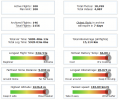- Joined
- Apr 5, 2018
- Messages
- 45
- Reactions
- 11
- Age
- 90
My favorite thing is flying long range.
Here are the things that come to the top of my head, how to get maximum from my flight:
- Turn off the obstacle avoidance sensor, to get more battery juice.
- Start low, and increase altitude slightly, every time when the RC signal bar decreases.
- Check the wind and consider that the Forced RTH spot, might not be enough and you need to RTH earlier than that.
- Do not press sticks to increase the speed, during RTH, because that drains battery faster.
- Do not fly in sports mode. Battery will drain faster.
- If you really going for LOOONG distance, make sure to set up a new, safe, home point somewhere along the way. So in case you will have to do emergency landing, and drive to pick up your bird - you know where it is, and it's safely landed.
What else, what other advice do you have for achieving maximum range on the long range flight?
Here are the things that come to the top of my head, how to get maximum from my flight:
- Turn off the obstacle avoidance sensor, to get more battery juice.
- Start low, and increase altitude slightly, every time when the RC signal bar decreases.
- Check the wind and consider that the Forced RTH spot, might not be enough and you need to RTH earlier than that.
- Do not press sticks to increase the speed, during RTH, because that drains battery faster.
- Do not fly in sports mode. Battery will drain faster.
- If you really going for LOOONG distance, make sure to set up a new, safe, home point somewhere along the way. So in case you will have to do emergency landing, and drive to pick up your bird - you know where it is, and it's safely landed.
What else, what other advice do you have for achieving maximum range on the long range flight?












